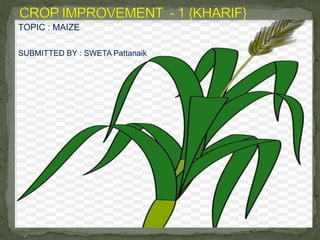
Maize Breeding Techniques and Varieties
- 1. TOPIC : MAIZE SUBMITTED BY : SWETA Pattanaik
- 2. Introduction Center of origin Distribution of species Wild relatives Breeding objectives Breeding methods Varieties Hybrids Breeding centers Conclusion
- 3. Zea mays chromosome no: 2n=24 o Corn is the queen of cereals and it is the important crop next to rice and wheat with regard to total area and production. o It is studied to a much wider range of climatical conditions than rice and wheat, because of its greater adoptability. Origin Central America Distribution USA, China, Russia, Canada and many south Asian countries. Progenitors: Zea tunicata, Zea teosinte . It belongs to the tribe Maydeae of family
- 4. Teosinte: There are three species of teosinte of which Zea mexicana is annual diploid (2n = 20) like maize. Gamma grass another close relative belongs to genus Tripsacum . The genes Zea characterized by male terminal inflorescences with paired staminate spikelets and lateral female inflorescences with single or paired pistil late spike lets. Genus Zea contains four species :- 1. Zea mays (2n = 2x = 20) = Corn 2. Zea mexicana (2n = 2x = 20) = Annual teosinte
- 5. Yield :Complex character controlled by polygenes. Attention is to be paid to have ideal plant type. Varietial hybridization as a maize breeding method did not gain popularity. The main reason for this is difficulty in getting superior segregants. Breeding for pest and disease resistance : Shoot fly, Stem borer, Heliothis are major pests. Mexican varieties are resistant. Downy mildews, leaf blight and helminthosporium are major diseases. Co1, CoH 2 are resistant. Taiwan lines are resistant to downy mildew. Breeding for high protein : Composed of two fractions. a) Protein in endosperm known as Zein which is nutritionally not balanced since it is lesser in lysine and tryptophan. 80% protein found in endosperm. b) Protein in germ (embryo) 20% balanced one. By increasing the embryo size we can increase protein content. Breeding for increased oil content. 12-15% in germ. By increasing the embryo size we can increase oil content. Alternate sources of cytoplasm CMS - T. susceptible to helminthosporium, C and S Resistant.
- 6. Introduction : Initially the varieties were all introduced one. Sikkim primitive 1 Sikkim primitive 2. Mexican line were first introduced during 16th century by Portugeese. • Mass Selection : Prior to 1945 mass selection was the only method used for maize improvement. • KT 1 - U. P. • RAS 1 - Rajasthan. • By adopting mass selection technique it is possible to get yield increase by 19% per cycle. • Ear to Row Selection : First proposed by Hopkins for improving oil and protein content of maize. This method involves selection of a number of phenotypically desirable ears out of a population grown in isolation. The selected cobs are harvested on single plant basis and keeping part of the seeds and remaining sown in rows. Based on the best performing rows during next season the reserve seeds are sown. This method is suitable for characters having high heritability like oil content and protein content. But it was not helpful to get increased yield. • Modified Ear to Row method : Proposed by Lonquist. I. Best ear heads from population selected (100 No.) and harvested on single plant basis. And threshed individually. II. The single heads harvested are raised in progeny rows in more than one location representing different environment with local checks. III. In the main station the progeny rows are used as crossing block. Pollen from
- 7. • Hybridization and Selection : Not popular since isolation of superior recombinants was not made. Heterosis breeding : Instead of using CGMS lines, detasseling the female inbred line is followed in India. Since use of CGMS line is costlier compared to detasseling it is not followed. Crossing the inbreds of indigenous x exotic origin resulted in release of best hybrids. Indian x Indian - 24 to 43% yield increase. Indian x U.S. dent – 58 % yield increase Indian dent x Caribbean Flint – 47 to 54 % yield increase . Population Improvement: Recurrent selection technique was initiated by Dhawan in 1963. The initial synthesis of composites were done from high yielding inter varietal crosses which exhibited minimum inbreeding depression. Hybrids / Variety 1. Single cross hybrid 2. Three way cross hybrids - Ganga -5, Trishulatha 3. Double cross hybrids - CoH 3 4. Double top cross hybrid - White kernel hybrids - Ganga safed
- 8. The International Maize & Wheat Improvement Center (CIMMYT), Mexico. All India Coordinated Maize Improvement Project, Varanasi. Indian Institute of Maize, Hyderabad. Indian. Institute of Maize Research, New Delhi. Conclusion The future research to enhance production and productivity of maize by improving yield potential through for single cross hybrid, Development of vigorus inbreed lines for better yield and tolernce to stress etc.